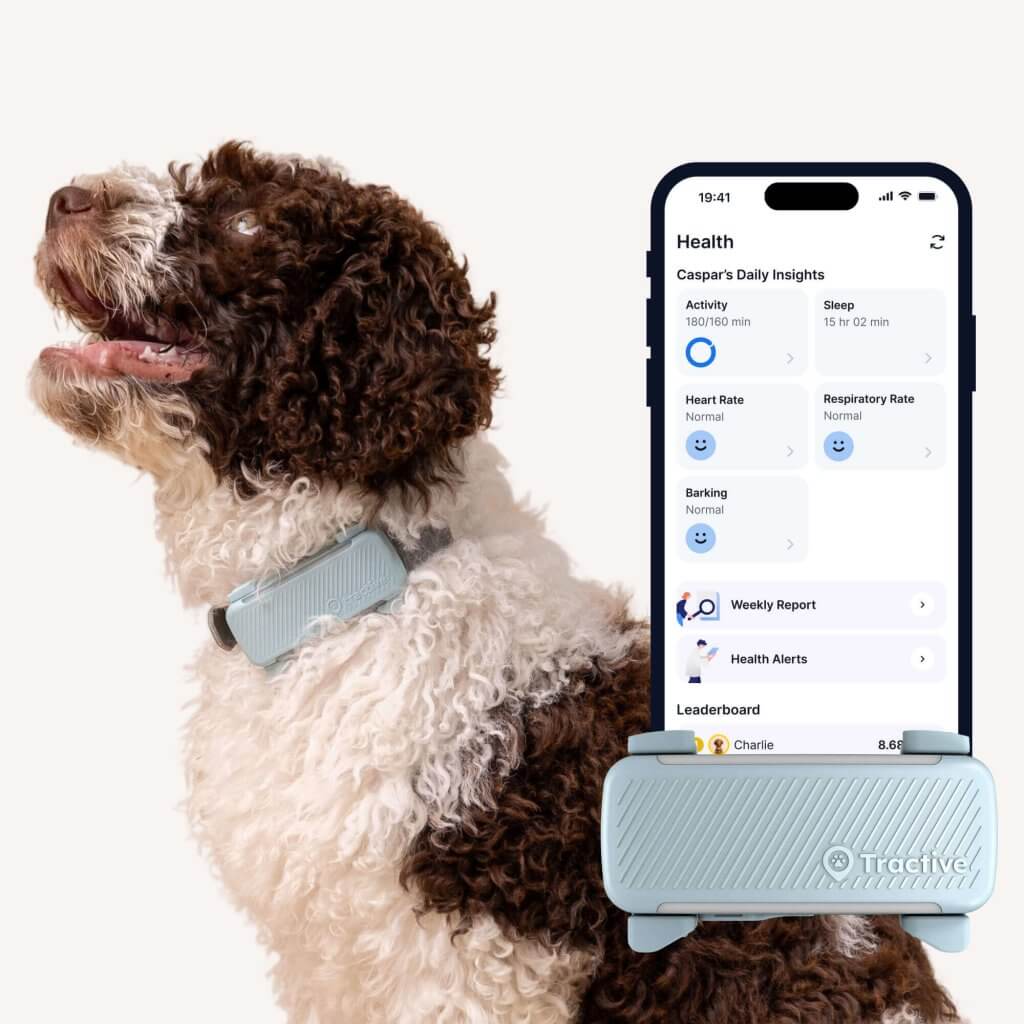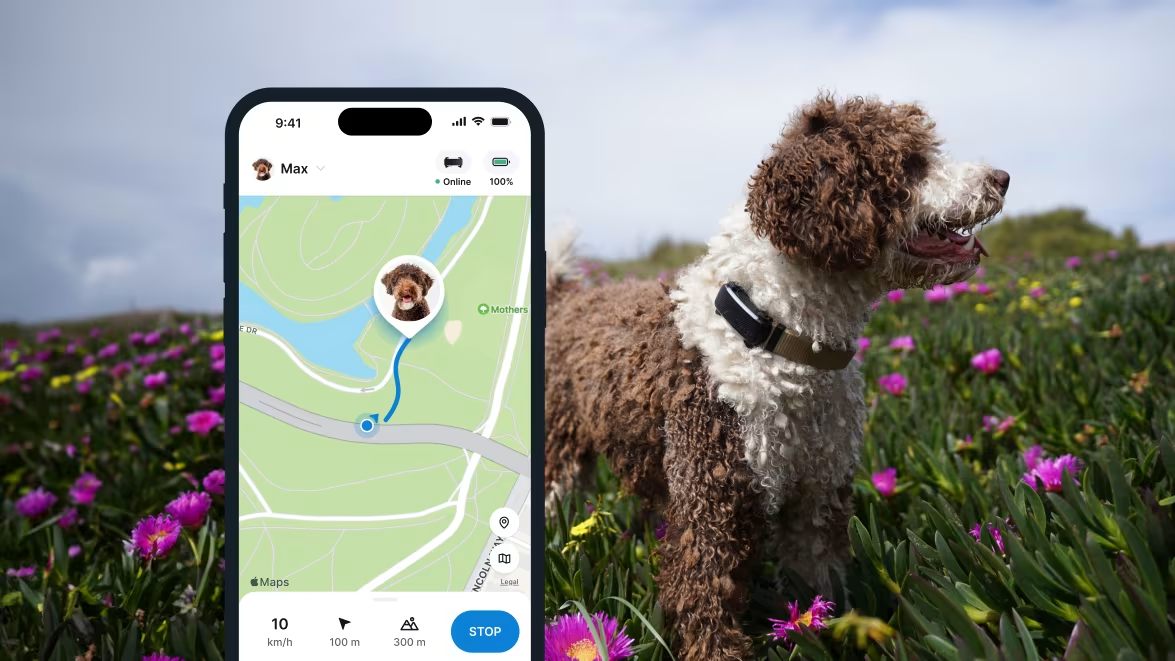Senior Dogs: Helping Your Buddy Age Gracefully
Your buddy's senior dog years are a big step. But when even is a dog considered a senior? And how can you best care for them in their golden years? Turns out actively monitoring their health is one of the best ways.

Much like humans, dogs go through a number of life stages – including growing older. So one of the most important transitions in your buddy’s life is when they become a senior dog. But you might’ve wondered: when is a dog considered a senior? And how can you keep an eye out for health issues that accompany aging?

Always know your buddy is healthy & safe
Read moreAt what age is a dog considered a senior?
| Size | Senior dog years |
| Small breeds | 10-11 years |
| Medium-sized breeds | ~10 years |
| Large breeds | 8 years |
| Giant breeds | 7 years |
You might’ve heard of the common myth that you just need to multiply your dog’s age by 7 to get their age in human years. But this is a pretty inaccurate estimate. Because dogs tend to age differently depending on their size, their exact age can vary across breeds. So here’s a chart that can help you figure out your dog’s actual age a little better:
Why do bigger dogs tend to age faster than smaller ones? Scientists aren’t entirely sure. One reason might be that because bigger dogs grow faster, they might be more likely to develop the abnormal cell growth associated with cancer.2 And because they age faster, they’re also more vulnerable to age-related illnesses. Even among bigger dogs, breed plays a role. Your buddy might be more vulnerable to age-related health problems if they’re a brachycephalic breed, like a Pug or a Bulldog.3
These are general guidelines and reflect the average of when most dogs get classified as seniors. Your buddy might age differently – so it helps to stay in touch with your vet to keep an eye out for the signs they’re getting older.
Signs your dog is getting older
A drop in your dog’s activity levels
One of the first signs your dog is getting older is if they seem generally more lethargic than usual. They might be more reluctant to go for their regular walks, tire more easily, no longer jump on the couch like before, or just seem out of it during playtime.
Signs to watch out for
- Movements.
You may notice your dog walking more stiff than usual, shifting their weight from limb to limb, limping, or struggling to get up and lie down easily. Or your dog might “lean” to their stronger side more often than the other. - Appearance.
At times, you might even notice your dog’s coat looking more matted and unkempt than before. (Because it’s difficult for them to reach these hard-to-groom spots if they’re struggling with arthritis or a similar health condition.) - Avoidance.
Your dog might also avoid certain surfaces, like those that seem slippery. They might also seem reluctant to walk up and down staircases. - Posture.
Your dog might also seem more “drooped”, posture-wise. They might not lift their heads to eat a treat or when you pet them. Or they might be more likely to lie down while eating or drinking.
Many of these signs and symptoms are also those of chronic pain. Plus, your dog might not be likely to draw attention to it. Making it easy to miss out on these signs until it’s too late.
A change in your dog’s appetite
A drop in appetite might be another sign your dog’s reaching their senior years. Senior dogs might pick at their meals or just seem less enthusiastic around mealtimes. Some of the reasons could include dental problems – including weakening teeth – or other underlying health issues, including liver disease.
If you’re noticing your buddy eating less, take a look at their teeth. Gently lift up the flap of their lips and check for the color of their gums. They should ideally be on the pink and moist side. If pale and/or sticky, your dog might be suffering some tooth pains. If you’re observing your dog eating less, any tooth trouble, or even changes in your dog’s weight as a result – get in touch with your vet immediately.
A drop in your dog’s responsiveness to you
Senior dogs are vulnerable to sensory and cognitive decline, including vision and hearing loss. They might also experience a drop in their mental acuity or responsiveness around these years. You might notice this if your dog seems less responsive – or takes longer to respond when you call their name. They might also stare vacantly or seem to “forget” their house training.5
In fact, blindness is one of the most common chronic health conditions that senior dogs may experience.6 Similarly, as their ears age, they might also experience deafness or a gradual loss of hearing. You’ll observe this if your dog wanders off past a point without hearing you call for them. Or seems to bump into things around the house more often than usual.
A change in your dog’s sleep habits
Like we’ve covered, older dogs are also vulnerable to cognitive decline, with conditions like cognitive dysfunction syndrome (CDS).7 You might see this turn up as changes in your dog’s behavior, like increased anxiety, confusion, or restlessness. But one of the key ways to pick up on changes to your senior dog’s mental state is their sleep.
Senior dogs experiencing cognitive decline might wake up more often at night – or generally experience less quality sleep. You might find them vocalizing more often at night or pacing around restlessly. Oftentimes, cognitive decline might be accompanied by other painful chronic health conditions which can also disrupt your dog’s sleep.

Get health alerts for your dog
Our pups can’t always tell us if something’s wrong. But if their tracker detects unusual changes in their routine, you’ll get an alert, helping you catch potential issues early.
What other health conditions are senior dogs at risk for?
Many of the signs and symptoms we’ve just covered might reflect chronic health conditions that senior dogs are at risk for. Here are a couple of them – and how they might show up:
Kidney disease
With time and age, your dog’s kidneys might be less able to properly filter out waste from their bloodstream.8 So you might observe your dog urinating more frequently. Or having accidents around the house because they’re less able to control their bladder. Dogs are also vulnerable to different cancers of their urinary systems, including bladder cancer.9
Thyroid disease
Your dog’s thyroid gland plays a role in their energy levels throughout the day.10 So with age, it might function slower and less effectively than before. This might cause your dog’s appetite and energy levels to plummet – while also increasing their risk of weight gain.
Heart disease
Much like older humans, senior dogs are also vulnerable to cardiovascular problems.11 And unfortunately, there really isn’t a single cause for it. Aging, nutrition, and their genetic history can all play a role in senior dogs developing heart disease. You might observe its signs if your dog tires more easily than usual when out on a walk. Or shows difficulties breathing. Certain dog breeds, like Boxers, might even be more vulnerable to disordered breathing like sleep apnea. Which can worsen any cardiovascular problems over time.
Liver disease
If you’re noticing your dog eating less at mealtimes, watch out. Liver disease tends to show up in senior dogs in different ways. Keep an eye out for:
- Loss of appetite
- Fever
- Diarrhea
- Seizures
- Vomiting
- Excessive urination and thirst
- Weight loss
If you’re noticing one or more of these signs in your senior dog, get in touch with your vet immediately.
Cancer
Much like humans, dogs are also vulnerable to developing different types of cancers. If your dog is aged 10 years or older, they might be at a higher risk of developing them. Here are a couple of the most common types of canine cancers:
- Melanomas, which can reflect a type of skin cancer. They’re most common among dogs with darker skin.
- Testicular cancer, which is most common among dogs who haven’t been neutered yet.
- Squamous cell carcinomas, which are most commonly found in your dog’s mouth and toes.
- Mammary carcinoma, which is highest among non-spayed dogs.
- Brain tumors, which might turn up as seizures.
- Osteosarcoma, which is the most common type of bone cancer in dogs. It might show up as limping, lameness, or difficulties staying mobile.
While these might seem scary, many of these conditions are preventable. By actively taking a role in your senior dog’s health, you can help them live a long, happy life by your side.
How to care for your senior dog’s health
Teach your old dog new tricks
Contrary to popular belief, it’s 100% possible to keep your dog mentally active through training them with new commands – no matter how old they are. If you start simple and work your way up gradually, you’ll both increase your quality time together while also keeping your dog engaged and happy.
A senior dog facing cognitive decline might display behaviors that go against their house training. (Like, for example, peeing inappropriately around the house.) So revisiting their basic obedience training is actually a great way to keep them mentally active. Plus, it can also help you catch on to any physical difficulties they’re experiencing early on. (If, for example, they’re reluctant to Sit, Come, or play fetch.)
Make regular grooming a part of your routine
A home-friendly dog grooming routine is a great way to build your bond with your senior dog. It can also help you to catch on to any skin, nail, and teeth conditions early on. With regular teeth brushing, you can identify any changes in your dog’s teeth and gums. Dental bacteria can often enter your dog’s system – and even infect other organs, like their heart. Regular coat brushing can help you skim through your dog’s skin and catch on to any lesions or sores. Plus, it can help keep your dog’s fur from matting or tangling, which can increase the chances of an infection. Finally, trimming your dog’s nails can help prevent mobility issues in the long-term. Plus, squamous cell carcinoma turns up most commonly in your dog’s mouth and toenails. So if you notice anything out of the ordinary, get in touch with your vet immediately.
Stay on top of your vet visits
With regular drop-ins at your local vet, you can detect health issues early and manage them more easily. Besides this, your vet can also advise you on what food options work best for senior dogs. Or prescribe you the right supplements and medications your buddy needs. Your vet could also advise you best on how to create a safe, comfortable environment for your dog at home. (Like special pillows and other items that can help, say, a dog struggling with arthritis sleep better.)
Consider pet insurance for your senior dog
If you’re concerned about the costs of multiple vet visits, consider investing in pet insurance for your senior dog. With a pet insurance policy, you can ensure your buddy’s getting the best possible care – without draining your bank account. Much like regular insurance, you’re reimbursed if your pet insurance policy covers the different services your senior dog needs. In the US, this might cost you around $47 a month – as compared to an unexpected vet visit, which might cost you anywhere between $800-$1500.
Let your dog outdoors more often
Even if your dog’s less active than before, they’ll still benefit tremendously from the outdoor time. Besides the exercise, they’ll also enjoy the sunlight, sensory stimulation, and the sights, sounds, and smells of nature. Outdoor time is also a great way to keep your senior dog mentally active. (Especially if you take them along on hikes and other outdoor adventures.)
Where a smart dog tracker can help
Even with the best intentions, our senior pups can sometimes wander or hide away when they don’t feel well. This is where modern technology, specifically a dedicated GPS and health tracker like Tractive, becomes an invaluable tool for peace of mind.

Strapped to your dog’s collar, you can now:
Let them outdoors safely
As dogs age, cognitive changes can sometimes lead to confusion or disorientation, even in familiar environments. A senior dog who wanders off is at a much higher risk than a young one. But if your old pal gets distracted on a slow walk or slips out the door, LIVE Tracking (pictured above) allows you to see their precise location in real-time, letting you bring them home safe fast.
You could also set up a safe zone around your yard, and Tractive will send you an immediate escape alert if your dog steps outside of it. This is a game-changer for dogs who might have trouble navigating back to the door or get confused in the dark.
Spot potential health issues early
With its built-in motion detector, Tractive tracks your dog’s rest and movement patterns. A sudden drop in activity or an increase in restless sleep are often the earliest, most subtle signs of pain, arthritis, or illness. If Tractive detects a significant change in their normal patterns, it sends you an automatic Health Alert. This data acts as an objective early warning system, giving you crucial information to share with your vet.
As your buddy approaches their senior years, your care and companionship can go a long way to help them age gracefully. By taking an active role in monitoring their health, you can address age-related health problems early on. And ensure a longer, healthier, happier life for your dog – by your side.





